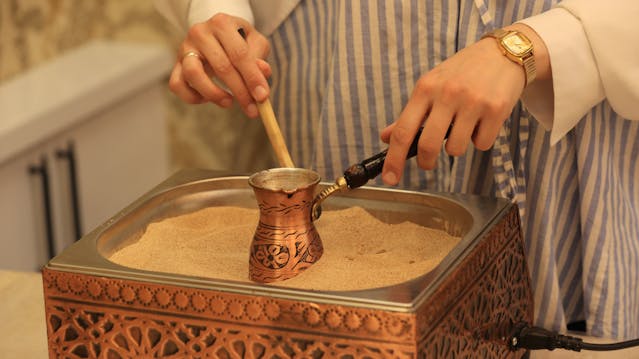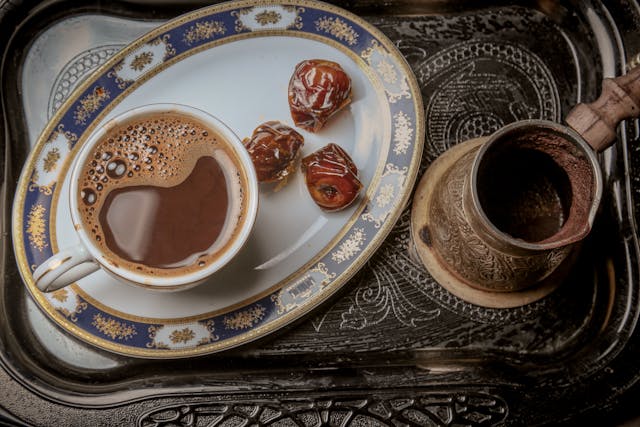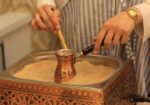The Ultimate Guide: How to Brew Authentic Turkish Coffee at Home

Welcome to the heart of our coffee culture. Far more than a simple caffeine fix, Turkish coffee is a centuries-old tradition, a ritual of hospitality, and a moment of pure, unfiltered connection. It’s a practice recognized by UNESCO as an Intangible Cultural Heritage of Humanity, and it’s a ritual I grew up with, learning its secrets from my grandmother’s patient hands.
Many outside our culture are intimidated by the process, but I am here to be your guide. Forget complicated machines and fleeting trends. Today, I will walk you through the simple, mindful steps to create the perfect cup of Turkish coffee in your own kitchen. We will focus on the story, the feeling, and the technique that has been passed down through generations.
The Three Pillars of Perfect Turkish Coffee
Before we begin, it’s essential to understand the foundation. True Turkish coffee relies on three key elements, each non-negotiable for an authentic experience.
1. The Coffee: A Powdery, Aromatic Grind
The single most critical element is the grind. Turkish coffee requires the finest grind possible, even finer than espresso. It should have the consistency of powdered sugar or cocoa powder. This flour-like texture is what allows the coffee to be brewed directly in water and creates its iconic body.
- Experience Tip: While pre-ground Turkish coffee is readily available (Kurukahveci Mehmet Efendi is a classic choice found in many Turkish homes), grinding your beans fresh will always yield a more aromatic and flavorful cup with better köpük (foam). If grinding at home, you will need a high-quality burr grinder capable of achieving this ultra-fine consistency.
2. The Pot: The Traditional Cezve
The magic happens in a special pot called a cezve (pronounced jez-VEY). This small, long-handled pot, often made of copper or brass, has a wide base and a narrow neck. This specific design is crucial; it promotes the formation of the rich, velvety foam that is the hallmark of a well-made Turkish coffee.
3. The Heat: Low and Slow
Patience is a virtue, especially here. Turkish coffee is never rushed. It must be brewed over low heat. This gentle heating process allows the flavors to be extracted fully without scorching the fine grounds, which would result in a bitter taste. It also gives you precise control over the foam as it builds.
A Step-by-Step Guide to Your First Turkish Coffee
This recipe is for one serving, the traditional way to prepare it. You can easily multiply the ingredients for more cups, but be sure to use a larger cezve.
What You’ll Need:
- A cezve (Turkish coffee pot)
- One heaping teaspoon of finely ground Turkish coffee
- One Turkish coffee cup (fincan) for measuring
- Cold, filtered water
- Sugar (optional)
- A teaspoon for stirring and scooping foam

The Ritual: Step-by-Step
Step 1: Measure Your Water
The most authentic way to measure your water is with the very cup you will drink from. Fill your fincan (a small, demitasse-style cup) with cold, filtered water and pour it into the cezve. This ensures the perfect ratio every time.
Step 2: Add Coffee and Sugar
Add one heaping teaspoon of your powdered coffee to the cezve. Now is the time to add sugar, if you desire it. The sweetness level is decided before brewing. Here’s a simple guide my family has always used:
- Sade (sah-DEH): No sugar.
- Az Şekerli (ahz sheh-ker-LEE): A little sweet (1/2 teaspoon of sugar).
- Orta (or-TAH): Medium sweet (1 teaspoon of sugar).
- Şekerli (sheh-ker-LEE): Sweet (2 teaspoons of sugar).
Step 3: The Initial Stir
Stir the cold water, coffee, and sugar together gently until the coffee is submerged and the sugar is mostly dissolved. Do this just a few times. From this point on, do not stir the coffee again. Stirring from here will disrupt the grounds and, most importantly, destroy the precious foam.
Step 4: The Gentle Heat
Place the cezve on your stove over the lowest possible heat. This is a moment for mindfulness. Do not walk away. Watch the coffee closely. After a few minutes, you will see a dark ring begin to form on the surface. This is the beginning of the köpük, the thick, creamy foam.
Step 5: Cultivating the Foam (Köpük)
As the heat gently works its magic, the foam will begin to rise from the edges toward the center. Just before it begins to boil—you’ll see the surface start to dome and swell upwards—lift the cezve off the heat. The key is to catch it before it boils over. Boiling will ruin the foam and make the coffee bitter.
Step 6: Share the First Foam
Using your teaspoon, carefully scoop the richest part of the foam from the cezve and distribute it into your waiting fincan. This ensures every cup gets a share of the best part.
Step 7: The Second Rise
Return the cezve to the low heat. Allow the coffee to rise a second time, again removing it from the heat just before it boils. This second rise develops a deeper flavor. Some traditions even call for a third rise, but two is perfect for a balanced cup.
Step 8: The Final Pour
Now, pour the remaining coffee into your cup slowly and carefully, pouring down the side of the cup to avoid disturbing the foam you’ve already placed there. The grounds will flow into the cup with the liquid—this is how it is meant to be.
Step 9: Patience and Enjoyment
Let the coffee rest for a minute or two. This allows the grounds to settle at the bottom of the cup, forming a thick layer of telve. The coffee is meant to be sipped slowly, never drinking the grounds at the bottom. It is traditionally served with a glass of water to cleanse the palate beforehand and a small sweet, like Turkish Delight (lokum), to complement the rich flavors.
FAQ: Your Turkish Coffee Questions Answered
Q: Can I make Turkish coffee in a regular saucepan? A: While you can try, you will not achieve the same result. The narrow neck of a cezve is specifically designed to create the thick foam. A saucepan’s wide surface area will prevent this from happening effectively.
Q: Why is my coffee bitter? A: Bitterness is almost always a sign of two things: the heat was too high, or you let the coffee come to a full, rolling boil. Remember, low and slow is the secret.
Q: Do I need to use a specific type of coffee bean? A: Traditionally, medium roast Arabica beans are used. However, you can experiment with different beans. The most important factor is not the origin but the ultra-fine, powder-like grind.
Q: What is the thick sludge at the bottom of the cup? A: That is the telve, the coffee grounds that have settled. It is an integral part of the experience and is not meant to be consumed. In our culture, the patterns left by the telve are often used for fortune-telling, a tradition called tasseography.
More Than a Drink, It’s a Ritual
You have now learned more than a recipe; you have learned a ritual. Making Turkish coffee is an act of patience and a gesture of hospitality. It’s a bridge to a rich history and a moment to slow down in our fast-paced world. I encourage you to embrace this tradition, share it with someone you care about, and enjoy the deep, authentic flavors of a coffee that has been connecting people for over 500 years.















